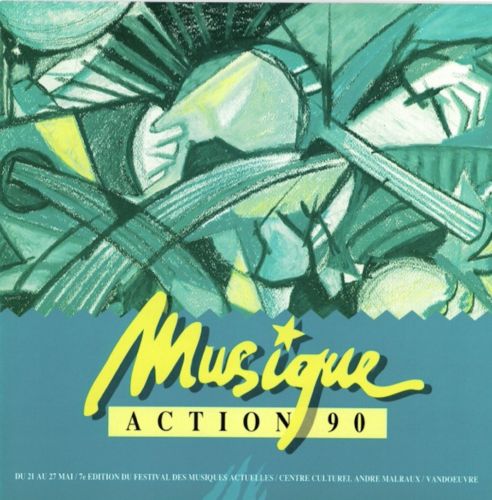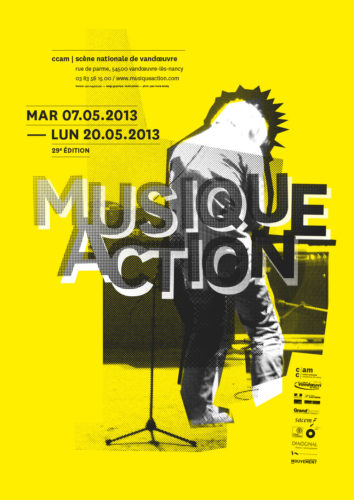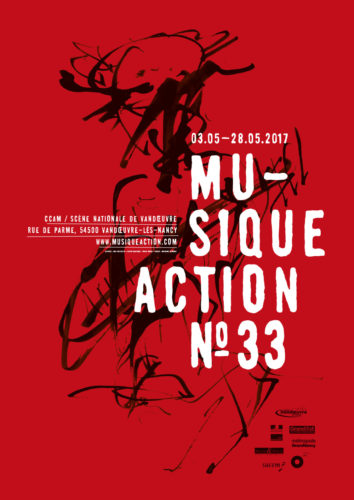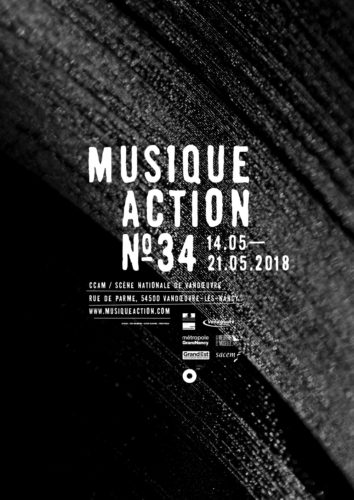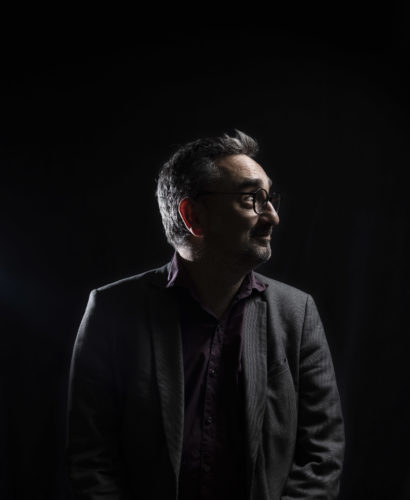The programme A l'Improviste on France Musique was born in September 2000 and very quickly put its microphones on the festival Musique Action There was a kind of obviousness there. The first time was in May 2005, during edition #22, for the recording of two concerts: the duo of Camel Zekri and Fred Frith, all guitars out, and the Mephista trio made up of Sylvie Courvoisier, Susie Ibarra and Ikue Mori. A look back at the images, and an informal discussion with the current management team of the CCAM and Musique Action: Anne-Gaëlle Samson and Olivier Perry.
Seventeen years already! I would be lying if I wrote here that I remember this 22nd edition in detail. However, certain images and impressions have remained vivid: the frantic rhythm of the concerts, a form of extreme vitality, of contrasts in all directions, in the programming, in the confrontation between the arts (written and improvised music, dance, text, images, musical theatre...) and the playing spaces (village hall, studio, auditorium, gallery, Médiathèque, MJC of Lillebonne...). Never before have I felt the kind of excitement and vertigo that comes from diving headfirst into so many different worlds for just a few hours as I did at the CCAM, a ship moored in the waters of Vandoeuvre-lés-Nancy. For the radio producer that I was, who came to improvised and contemporary music rather late in life, each proposal from Musique Action was almost a first time: I discovered and learnt a lot through this festival, and I still feel a huge debt. Dominique Répécaud, and his team, welcomed the radio with a mixture of distance and generosity. I remember a committed, omnipresent director, running from one concert to another, always welcoming, often exhausted! The dense days and short nights graced his deep, radio-friendly voice with a few even deeper notes, when I held out my microphone to hear him talk about the festival.
Musique Action has left me with many strong images in which sounds, bodies (including that of the dancer Marie Cambois), images (many fascinating exhibitions, including that of Johnny Lebigot), and spaces (among others the superb duet of Sophie Agnel and Ikue Morie in the gallery, and the installation of Hugo Roussel on edition #33: 12 amplified electric guitars, in memoriam D.R.). I have discovered so many artists at Musique Action that it is pointless to name them all here. For all these years, A l'Improviste has tried to give listeners a palpable sense of this festival, either through concerts captured on the spot or through reports.
In 2014, two programmes in the form of a mosaic entitled "A special day at the Musique Action festival" took the decision to relive two long evenings of the 30th edition of the festival in sound and words and at a steady pace (the festival-goer's vision). For the evening of 30 May, the sounds of Sophie Agnel's cordophone, the Bruits de couloir by Marc Pichelin , Kristof Guez & Frédéric Le Junter(Cie Ouïe Dire), the Filarium by Jérôme Noetinger, Michel Chion & Lionel Marchetti, the quintet by Daunik Lazro Phil Minton, Ana Ban (Dominique Répécaud himself) & the duo Kristoff K.Rolland the drum duo of Yuko Oshima and Christophe Sorro... And for the next day's show, sounds from a solo by Daunik Lazro, the quintet La Banquise ( Françoise Toullec, Claudia Solal, Louis-Michel Marion, Michel Deltruc, Antoine Arlot), La Bohemia Electronica...nunca duerme by the duo Kristoff K.Roll, the combination of words and sounds of Franz Hautzinger's Poet Congress, or the Klang trio of Sophie Agnel, Catherine Jauniaux & Yuko Oshima ... The tempo of these two broadcasts had visibly "resonated" with Dominique Répécaud, who told me that he had rediscovered the spirit of his festival!
In 2017, the 33rd edition, programmed by Dominique Répécaud, was held without him.
Among the programming ideas that were dear to him, there was a quintet gathered around the two guitarists Camel Zekri and Fred Frith (the famous 2005 duo recorded by A l'Improviste!), with the guitarist Gilles Lavalthe drummer Ahmad Compaoré and Romain Baudoin on the hurdy-gurdy. We remember that the music improvised by the musicians had unfolded throughout a heady melody, on the letters D.R., alias Dominique Répécaud. This idea had occurred to Fred Frith before the concert, in the airport waiting room. All of them (except Romain Baudoin, a newcomer) had a strong link with the festival and Dominique Répécaud. Of course, Musique Action #33 was not an edition like the others! A magazine was passed from hand to hand: a special issue of Revue et Corrigée, entirely dedicated to the musician, programmer, producer and passer-by that was Dominique Répécaud, who died suddenly a few months earlier, in November 2016.
Today, at the helm of this vessel, is Olivier Perry, who, together with Anne-Gaëlle Samson, co-director of the CCAM, programmes the editions of this festival in full evolution, between continuity (the heritage of more than 30 years of festival) and discontinuity, or let's say necessary changes.
For Olivier Perry, " a festival is a form of living organism - it is therefore logical that there are cells already in place, and others that are renewed, and that the path between the two is made. Today we are at a moment of decompartmentalisation. In the past, aesthetics were conceived in opposition, in very distinct places. Today we see more and more cross-fertilisation between aesthetics, and with Musique Action we want to move towards more convergence. Of course, one might fear that in the long run all the festivals will look the same if they follow this line, but I think there is still room for improvement! Finally, if we look at the festival's archives and if we look at the book of interviews made by Henri Jules Julien in 2008, Musique Action - Sound clearingYou can see that this friction between aesthetics has always been present here, with more or less marked phases. In the early years of Musique Action, many styles of music crossed paths at the CCAM: you could meet musicians of learned music or contemporary written music, jazz, rock in position... Over time, electronic music came more strongly. This eclecticism is part of the festival's DNA and is also what makes it so rich. When I discovered Pascal Comelade in 1992 at Musique Action (and especially Pierre Bastien who shared the stage with him, a real revelation), I discovered very different things at the same time! For the student I was in the early 90s, Musique Action was a kind of well where I could find unheard of things. I came to Musique Action as a spectator until 2001. Then I had to leave the region, but I continued to listen to this music, to discover other festivals, until the day I came back to live in Nancy. I applied for the position of director of the CCAM in 2017, because I felt that in order to direct this place, I had to have an interest in this music, that it was important to take on the heritage of this festival, and that at the same time it could be useful to have knowledge of other sectors of the performing arts, in order to operate a form of synthesis.
Anne-Gaëlle Samson has been part of the CCAM and Musique Action team since 2011. She is therefore well placed to talk about the changes that are taking place between the two visions of the festival proposed by Dominique Répécaud, and then Olivier Perry. Passionate about dance and theatre, she came to creative music in an organic way, thanks to the festival and dance. The interdisciplinary nature of Musique Action has always been an added value for her.
"At Musique Action there has always been a demand for sound, which has always been at the centre of the programming, including the choreographic projects. I remember choreographies that were not programmed because this concern for sound was missing. Dominique had this constant preoccupation, as he had that of transmission. He transmitted a lot to the artists who came here and who grew up with the CCAM. I remember that when we received artists in the office, Dominique always asked them about their relationship to sound. When we came to see him to talk about a project for a show, we usually left with a number of playlists, things to listen to (he would say: "listen to this"!) and this formed the ear of the choreographers and theatre people. He did it with a lot of generosity. He knew so much music and musicians!
Anne-Gaëlle Samson does not see the evolution of the festival in terms of continuity/discontinuity, but she insists on the change of era: " Between the Musique Action of yesteryear and the one of today, there are places of continuity, of common love, and also places of opening up to other fields, and of questioning. Today, the CCAM undoubtedly does not have the same relationship with the public and the repertoire. On the long evenings of the festival, it is clear that the music played here brings together an audience that is already familiar with most of it. This was not a problem in the last few years of the festival when Dominique was in charge, but today the question is more pressing. I'm not saying that Dominique didn't ask himself this question, but it wasn't the main point of his questioning, or let's say that we can follow in his footsteps today, to go further. This is a question that is very much on our minds! For us, it is an essential subject, as is the question of the presence of women in programming.
Anne Montaron



)

